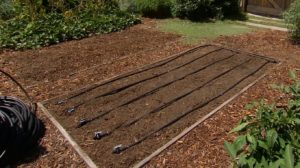Have you ever wondered how much water arugula needs? There are many things that arugula likes to be happy, but water is at the top of the list! Whether you’re growing it in your garden or you’re buying it from the store, making sure that your arugula always has enough water available to it can make the difference between having delicious, crispy arugula or arugula that tastes like wood chips. Read on to learn more about how much water arugula needs and how much water different kinds of arugula need.
Most arugula plants need at least an inch of water per week. If you notice your plants becoming limp, wilted, or brown around their edges that’s a sure sign they need more water. Ideally, you should give them at least 1/2 cup of water per day for every 6 inches of plant height. Give each plant an individual soak using a watering can or hose and allow it to drain before adding more water.
Arugula, also known as roquette and rucoli, is a leafy green vegetable belonging to the brassica family. Derived from wild radish, arugula is believed to have originated in Greece or Italy (or maybe Pakistan), where it has been eaten for millennia. From there, its popularity spread westward into France and eventually throughout most of Europe. The scientific name of arugula is Eruca sativa. It’s been used by indigenous people in America as well; Iroquois Indians called it rahoketo, meaning the strong smelling one.
Amount of water needed
When it comes to farming, arugula has a number of needs. Arguably one of its most important needs is water. Plants need an ample amount of water to thrive; otherwise, they become malnourished and start to wither. You should ensure that your arugula plants receive adequate water—but how much is adequate? It’s hard to say exactly because there are so many variables in play. For example, arugula grown in colder temperatures will require more water than arugula grown in warmer temperatures. Additionally, if you live in an area with high levels of rainfall or humidity, you may not have to provide as much water as someone who lives in a drier climate with less rainfall or humidity.
When to water
The key to properly watering your arugula is to do it when it needs it. Generally, arugula should be watered as often as twice a week, depending on its type and growing conditions. If your arugula’s leaves are starting to yellow or turn brown, that means it’s experiencing drought stress. On the other hand, if they’re dark green but have wilted edges (as opposed to just drooping), you may be overwatering. Make sure you water deeply enough so that water penetrates at least 3 inches into soil; otherwise, nutrients will not reach roots. Overwatering can cause root rot, which can kill plants quickly.
How to tell if your plants have enough or too much water
The easiest way to tell if your arugula plants have enough water is to stick your finger a half-inch into soil and feel for dampness. If it’s dry, you know that it needs water; however, too much water can drown plants so be sure to only add a little bit of water at a time and let it seep in rather than spraying or sprinkling all over. Adding mulch around plant roots also helps keep moisture in and prevent weeds from growing up through your arugula.
Soil selection
Although arugula is not a fussy plant and will grow in a wide range of soils, it performs best in sandy loam or loamy sand that is rich in organic matter. The pH should be around 6.0 to 7.0. Although arugula is fairly tolerant of low fertility soils, adding some compost or manure to your soil before planting will give you a better crop, especially if your soil has been treated with chemicals for pest control or fertilizers for other crops, such as corn or tomatoes.
Will arugula grow back after cutting?
One of my pet peeves is plants that won’t come back once you cut them down. I buy greens like arugula and mizuna, and when I realize it’s almost time to harvest them (within a few days), I get a little sad. Cutting these plants down seems to be irreversible. Fortunately, I learned that there are techniques to help your arugula come back year after year. You will be able to harvest fresh arugula all summer long!
Just follow these steps: Put 2 or 3 inches of mulch around your arugula bed, burying as much of any stalks that remain in the soil. The mulch will help retain moisture and keep weeds from growing up through it.
When you’re ready to harvest your arugula, just pull back a little bit of mulch to expose some leaves and cut them off at ground level. The remaining plants will continue to grow and produce new leaves for several weeks after you’ve harvested them. By following these simple steps, you can enjoy fresh greens all summer long!
Does the arugula plant need full sun?
When grown in optimal conditions, arugula is a fast-growing plant. Arrange your arugula plants so that they receive at least 6 hours of sunlight each day to ensure vigorous growth.
However, keep an eye on your arugula’s watering needs; if it doesn’t get enough water, it will begin to yellow and die within weeks.
Arrange for more frequent watering during hot weather or when growing several plants together in a garden bed.
Keep in mind that arugula is an annual plant; once it goes to seed, it will die. If you plan to save seeds from your arugula plants, keep them well-watered and protected from extreme temperatures until they’re ready to be planted again next year.
Can arugula grow in shade?
Arugula is a cold-weather vegetable. It likes cooler temperatures, but it won’t thrive if kept in full shade. If you want to grow arugula indoors, then you will need to make sure that there is plenty of natural light so that it can photosynthesize. However, if you keep your indoor herb garden away from windows where direct sunlight shines on it, then arugula can thrive in the partial shade all year long (as long as there is some light). Soil moisture: Arguably one of the most important factors when growing arugula, even though not many people realize it.




